Written by Joel T. Lewis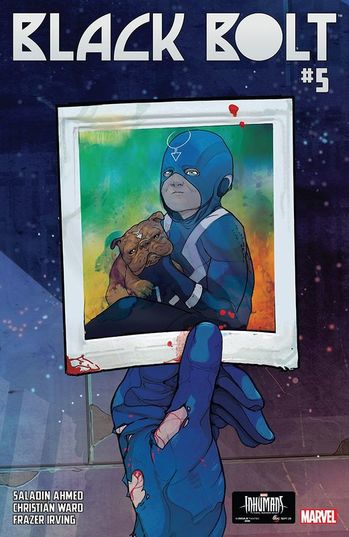 This issue of Black Bolt began with a response to the brilliantly retold Absorbing Man origin story in issue 4. Over the course of the first 4 pages, guest Artist Frazer Irving retells Black Bolt’s origin story from the point of view of his faithful pup Lockjaw. Irving’s style and texture is a great contrast and complement to the sleek polish of Christian Ward who illustrates the rest of the issue. As he depicts the classic tale of the Inhuman Prince and his teleporting dog, Irving’s panels are gorgeous. My favorite panel in these early pages is one showing Lockjaw flanked by Black Bolt, Ben Grim, and a fiery Johnny Storm. These quick snapshots of Black Bolt’s past accomplish two goals: one, they are a great recap of the Black Bolt Origin for somebody new to the character, and two, they firmly establish the special bond between the silent King and his massive pooch. As the artistic reins are handed back to Christian Ward we find Black Bolt finally freed thanks to his faithful pup. As his power returns, Black Bolt is torn over his next steps. Usurped and betrayed by his brother Maximus the Mad, Bolt wishes to return to Earth in order to expose the cruel farce his brother has been playing out posing as the king of the Inhumans. However, because of the bonds he has formed with his fellow inmates in that cosmic nightmare of a prison, and his faith in his wife Medusa’s ability to handle Maximus, Black Bolt decides to return to rescue his friends. After freeing Crusher Creel, Blinky, Metal Master, and Raava and capturing the vile guard Spyder, Black Bolt charges ahead to confront the powerful telepath at the center of the prison, the Jailer. Spyder manages to spring a trap and in the process, seriously injures Lockjaw. Amid a spectacular two-page spread of wild combat and action demonstrating the power of each of the former captives, Black Bolt unleashes his full power against Spyder, disintegrating him. Do not mess with Black Bolt’s pup. In order to end the madness of the cruel prison, the company must leave the wounded Lockjaw behind and they discover another layer to the mystery of the Jailer. 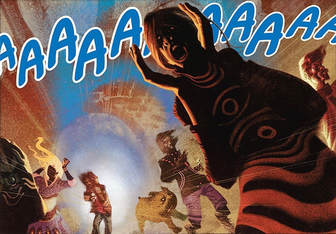 The first inmate of the prison they have come to despise was in fact their Jailer. A telepathic vampire who regained his powers and was able to feed on the villains of the cosmos for centuries undiscovered, the Jailer unleashes one last defense before the conclusion of the issue. The group of former inmates turn around to discover a shimmering legion of ghosts. The ghosts of their loved ones. The angry ghosts of their loved ones. Saladin Ahmed is doing a spectacular job of making one of the most stoic and inaccessible figures in Marvel Comics into someone you can instantly relate to and want to root for. It’s not just that he has a comically large dog, it’s not just that that comically large dog is instantly and forever loyal to him, but it might be that the juxtaposition of that silly, slobbering pup and the joy he inspires from a stern serious figure like Black Bolt that gives this issue, and by extension Black Bolt, such charm. The additional artistic support of Irving in no way confuses or diminishes Ward’s ability to light up every panel he touches. A particularly spectacular panel depicts Crusher Creel after he absorbs one of the prison’s containment devices. For a character whose costume consists of not wearing a shirt, as Black Bolt pointed out last issue, the versatility of what Creel absorbs is where the artist truly shines. Liquid blue punctuated with streaks of eerie pink is a good look for Creel and Ward’s design is impressive. I can't wait for issue 6 when Black Bolt comes face to face with the parents he accidentally murdered as a baby. Until next time, Geek On!
0 Comments
Written by Joel T. Lewis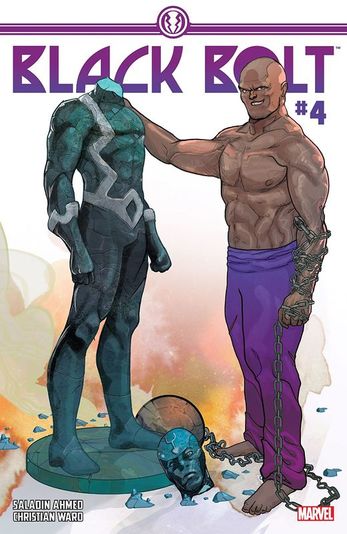 One of the things I love about comics is the unending amount of intercontextuality within the universes. Absorbing Man Carl ‘Crusher’ Creel has been a part of the Marvel Universe since 1965. With numerous appearances of varying significance, one could trace his character arc from his first appearance in Journey into Mystery #114 to the present day. This is the case for basically all of comic book characters, but there has to be some motivation for tracking down and deeply immersing yourself in a character who may not be on the A-list of villains. The great thing about comics is that the stories that spark that obsessive motivation, those issues that reshape a character’s value in your mind, come more often than you might think. Crusher Creel is one of those characters and Black Bolt #4 is one of those issues. The opening page of this issue is one of the most succinct and successful recaps I’ve ever seen in comics as Author Saladin Ahmed and Artist Christian Ward drive home the events that have led up to Black Bolt’s most recent predicament with brevity and minimalism. In panels that dwindle in size, ward portrays the downward spiral of Black Bolt’s life to the current moment, where we find him and Crusher Creel trapped in a chamber where Jailer is slowly pumping out all the oxygen. Unable to escape from their bonds, Crusher resolves not to die in silence, an ironic and poignant decision the effect of which is not lost on Black Bolt, a man who has spent most of his life in silence. Creel imparts his life’s story to Black Bolt in a beautifully executed montage of color, style, and prose as both Ward and Ahmed make you fall in love with Creel as they play with the B-List villain’s origin. Take a broken home, an abusive father, a passionate boxer, a lower level enforcer, then add a magic potion and that’s how you get the Absorbing Man, and while the progression of Creel from well-meaning youth to Thor-Smashing B-Lister isn’t too innovative, the way Ward portrays it is. The collage of heroes, villains, and flashbacks contained within this issue could pass as a professional artist’s portfolio as Ward slips effortlessly from style to style, masterfully matching color to concept and executing the nostalgia and emotional weight of each panel with precision. It really is an issue you have to see to believe, and it marks a great jumping-on point for this series, which is unique for the fourth issue in a series. I would be doing this issue’s architects a disservice if I didn’t mention how perfectly this issue’s cover art captures the spirit of what goes on between the pages. Through the heartfelt vulnerability that Creel shows in his revelations to Black Bolt, Bolt himself is laid bare and vulnerable and the stony facade of the silent Inhuman King comes crumbling down around a very hurt and sensitive being. What a great way to make a classically stoic and alien figure like Black Bolt relatable and engaging. This near-death heart-to-heart shared by these two men is beautiful and has made me love both characters all the more for it. We even get to see Black Bolt laugh! Just moments before all of the oxygen is removed from the cell, Creel gives Bolt a cheesy one-liner joke and the two share such a pure moment of laughter. Both men, exposed and vulnerable prepare for their last moments when suddenly Lockjaw, Black Bolt’s teleporting pup, appears and whisks Bolt away. Creel is left alone and we are left to wonder if Bolt will return to rescue his unlikely friend. This issue was special. This series is special. This creative team is wildly talented and I cannot wait to see what they do in issue 5. Until next time, Geek On! Written by Joel T. Lewis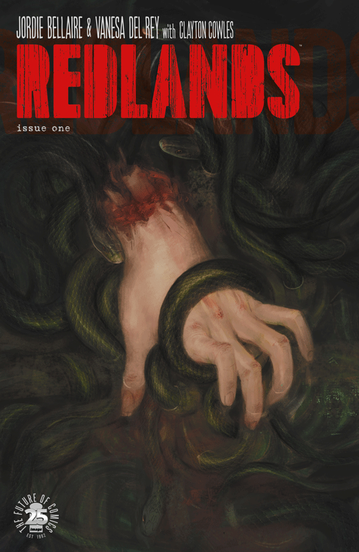 The ‘victims’ of violence in Redlands number 1, set in 1977 Redlands, Florida are sexists, racists, and murderers. And what colorist extraordinaire (and now author) Jordie Bellaire and artist Vanesa Del Rey do to these pillars of white supremacy and the patriarchy via their three Witch protagonists is just about the most violent, terrifying, and vibrant carnage I've seen between the covers of a comic book. And it's damn satisfying. If you read comics even causally, chances are that you've seen the name Jordie Bellaire more than once. Jordie is one of the comic book industry's most talented colorists whose credits include Injection, The Punisher, Batman, Moon Knight, and Vision to name just a few. Regardless of the artist, or publisher for that matter, Bellaire elevates the comics she contributes to with a particular eye for shadow and textures. In her debut as a comic book writer, Jordie Bellaire begins Redlands issue 1 with a group of bigoted cops barricaded within their police station, watching in disbelief as the tree they tried to lynch our mysterious Witch protagonists from is engulfed in flame, and the would-be hang-ees are nowhere to be found. It's unclear what led to their attempted lynching or how they came to visit Redlands in the first place, but it becomes apparent very quickly that however monstrous the witches might be, the true villains of this story are the policemen. From the confederate flag flying in the background of the police station, to the racist and rape-culture rhetoric spouted by the Sheriff and his son, Bellaire quickly sets up a clever dichotomy of monstrous figures: the bigoted police force of 1977 (and there are clear hints that we may not have moved too far away from that type of bigotry in the modern day) and the horrific specters that terrorize them. The home invasion style horror narrative wastes no time in splattering blood all over the panels as the first police causality is decapitated rather gruesomely by a black wisp of shadow. This officer, dying while ushering a mysterious child inside the walls of the police station, thuds to the ground and the police rush to more thoroughly barricade the doors. The Sheriff, in response to his confused son’s questions about what to do, crunches the butt of his shotgun into his face. While this first impression of the Sheriff is by no means the vilest, it does a great job of showcasing this character's lack of compassion. Sent to check on the delinquent occupants of the station’s holding cell, the Sheriff's son proceeds to demonstrate serious prejudice against the people of color behind bars and casually refers to sexually assaulting women. Needless to say, as a reader at this point in the issue I was onboard with whatever messy end Bellaire had in store for these guys. 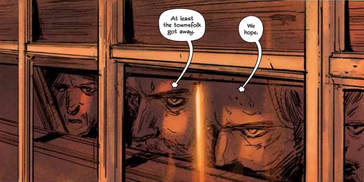 We then discover that the mysterious child who the police let inside the station is not what she appears as she twists and shifts among the shadows into a creature like a Minotaur and then into a terrifying banshee creature. In the confusion and violence caused by the mysterious child, the Sheriff's son finds himself outside taken hostage by another specter. The Sheriff, in an attempt to save his boy (whose nose he shattered just a few short pages ago) fires at the new specter, misses, and ends up killing his son instead. The razor sharp shadow, the empty nooses hanging from the tree outside the station, the shapeshifting child, and the three Witches we meet at the end of the issue are haunting and executed brilliantly by artist Vanesa Del Rey. One of my favorite visual elements of this issue was Del Rey’s beautiful and eerie moth who overhears the police’s sexual assault rhetoric. The detail and precision of Del Rey’s work is outstanding and the moth reminded me of the larger part those creatures played in my favorite thriller, The Silence of the Lambs. But where this book really stands out (appropriately) is in Bellaire’s masterful color work. Shadow, firelight, carnage, and gore are all brought to vivid life by one of the most prolific and talented colorists in comics today. It is Bellaire’s skill and use of shadow that allows the horror of this comic to succeed. By drenching her shape shifting child character in the right light, the terror you feel when you see her true form is made all the more dramatic. Fire burns brighter, blood shines redder, and shadow looms more ominous because of Bellaire’s mastery of color. There’s not much more to sum up in terms of plot for this first issue. Suffice it to say that a trio of Witches enact some gruesome, but righteous, violence on a group of bigots and I thoroughly enjoyed the ride. Horror is a great genre for critiquing injustice and bigotry as fear and cruelty can be applied to supernatural elements of fiction, as well as prejudice and supremacy in real life and Bellaire's narrative is fearless in its commentary on fear. This is a mature comic, and an important one. I cannot wait for issue 2 and I’m happy to have gotten in on the ground floor of what promises to be the long and illustrious career of Jordie Bellaire the author. Until next time, Geek On! Written by Joel T. Lewis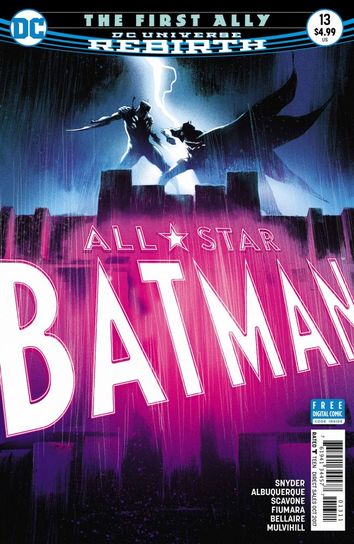 After narrowly escaping a jumbled bloody death under the tons of concrete and glass sent tumbling to the ground by the Black and Whites, Batman and Alfred begin a short-lived pursuit of Hush and company to the Silent Key Retreat owned by Hush’s parents in his youth. As our heroes draw nearer to their would-be murderers, Snyder sends us back in time once again to uncover another layer of Alfred’s history with the Nemesis Program. We catch up with a turbaned Alfred nearing the end of his Nemesis training in Morocco. Through panels of spectacular quality, we see Alfred complete a mission to transport a deadly disease to his mentor Briar using his own body as a host. The dexterity and commitment to the mission that Alfred demonstrates in these flashbacks mirror the qualities that he shapes and encourages in Batman later on. In a quiet moment of rare vulnerability following the mission Briar reveals to Alfred that his own son took on the mantle of the Black Knight and was killed when he jumped in front of a bullet meant for Briar. Briar laments the weakness and vulnerability of his former pupils because of their preoccupation with the loved ones they've left behind. Briar’s unsettling revelation leads Alfred to snoop around in his mentor's files and he discovers that in order to make him a more perfect Black Knight, Briar has plotted to murder his father. In the present, Snyder shows us that as Batman catches up with the Black and White’s helicopter which he discovers was ambushed and that the people aboard are seriously injured. Unwittingly springing their well-placed trap, Batman is quickly dispatched by Briar and the Black Knight. Briar taunts Alfred over Batman’s comm system, telling him that he plans to use the Genesis Engine to reprogram Bruce into the perfect Black Knight that Alfred failed to be. Filled with righteous rage, Alfred returns to the Pirate Base from a few issues previous and recruits the now-leaderless compatriots of the Pirate Thatch to assist him in rescuing his son. Issue 13 closes with an image of Alfred strapped like a pirate version of the Punisher, ready for war saying, ‘Yo $%^& Ho. Get your guns, mates. You're coming with me.’ 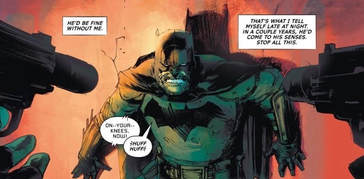 Apart from particularly gorgeous art and color work courtesy of Rafael Albuquerque and Cris Wands and Punisher Pirate Alfred, issue 13 of All-Star Batman presents perhaps the best and most pointed visual representation of the effect that Batman has on those closest to him. As Batman and Alfred careen towards the earth surrounded by tumbling sheets of glass and concrete in the opening sequence, their desperate struggle mirrors that faced by those tangled up in the Batman Crusade. Alfred, seeing the impending demise of his precious son, struggles to free Batman from the duty of saving his life. Were he not bound by duty to save his surrogate father, Batman’s descent would become simple and easy. However, Batman clasps all the tighter for Alfred’s struggling, overcoming even the ripping of his cape (their only hope for slowly down and landing safely). Batman wills his success into existence, defying the physical limitations of his equipment, and finding a way to win, a way to continue his impossible quest. In those moments of struggle, Alfred stands for all who come into contact with Batman. Grayson, Todd, Drake, Barbara and Jim Gordon, have all resisted and inevitably fallen victim to the twisted web of Batman's mission. The significance of this sequence of pages is that we see the person most near the center of the Bat-Family fight and kick and scream against the will of the Batman. All to no avail. The mission is accomplished and Batman comes out on top regardless of how Alfred feels about it. With the strength of the fatherly themes Snyder has developed in this arc, it's important to remember that Alfred, compassionate father that he strives to be, is powerless against the whims of the cruel Batman crusade, more so than any sidekick, collaborator, or even Arch-Nemesis. Alfred truly is Batman’s First Ally but in many ways he is Batman’s first victim as well. The next issue of All-Star Batman will be the last, and though I'm sad to see this series end, I'm very excited to see how this final storyline wraps up. Until next time, Geek On! Written by Joel T. Lewis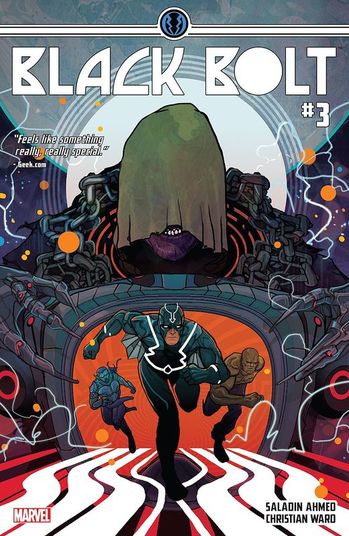 Saladin Ahmed and Christian Ward’s Black Bolt No. 3 has all the components of the perfect prison break story. A well-balanced and diverse crew whose personalities clash enough to create sparks but not fire, a plan with room for heroism and improv as opportunities to rescue fellow inmates arise and new obstacles appear, and finally it has to be visually interesting to watch unfold. As Crusher Creel, Black Bolt, and Raava face off against the grotesque guard Spyder in order to reclaim their unique abilities there is time for quips, camaraderie, and Ward’s spectacular use of color and character design. Dispatching the guard quickly, Black Bolt and company secure the device that will allow them to rescue Metal Master and the many-eyed child Blinky, and hunt down the cruel Jailer. As the rag tag group reunites and their powers flood back into their bodies, Ward treats us to a two-page spread showcasing the renewed strength of each character. Black Bolt’s panel, which bleeds over and behind those around it, is particularly well executed as the Inhuman monarch swells with power. The would-be escapees then encounter a massive being in the next cell over whose initial strike of defense is mistaken for aggression. Blinky, using her telepathic ability, discovers that the massive being is only a child of his species and reacted out fear and not malice. Following this misunderstanding the group discussion over whether or not to enlist the monstrous child in the hunt for the jailer is quickly silenced by a particularly vocal and passionate Blinky, despite the insistence of Raava. Moving on in pursuit of the Jailer the team discovers that at the center of the massive, bizarre prison is a massive combustion engine. An engine fueled by the suffering of the prison’s inmates. The Jailer appears and after a wild technicolor battle which concludes with the newly re-powered Black Bolt whispering the word ‘Die,’ it is revealed that the jailer is far more terrible than the apparition they were led to believe was the Jailer. The true being is massive and in segments, hooked into the infrastructure of the prison, and a terribly powerful telepath. As the issue ends, Black Bolt is ripped from the fabric of reality, head first, and his unspoken scream dies in a throat fading into white light.  This issue, apart from serving as a well-crafted prison-break storyline, intensifies the level of cruelty and injustice on which the space prison operates. The cruelty and misunderstanding that the colossal child’s incarceration represents makes us and Black Bolt question the fate he had decided his brother Maximus the Mad deserved. The child certainly did not deserve to be tortured and then fed off of in the way the Jailer sustained himself. Can Black Bolt believe that Maximus, villain though he is, had earned this level of cruelty? We also get a passionate vocal development in Blink’s character as she steps in to stop Black Bolt from harming the colossal child. More than just a child figure herself, an object to be imperiled and rescued, with her powers reinstated, Blinky proves to be wise, compelling, and compassionate. Ironically enough, it is the power of Blinky’s voice, her shout of ‘Listen,’ which compels Black Bolt to stop his attack. It will be interesting to see if her character is lost to the winds after the Black Bolt series or brought into to some more cosmic storylines. I would love to see her interact with Moon Girl and Devil Dinosaur perhaps, or some mini-series where she and the colossal child make their way home. It’s always exciting to see new and interesting female children characters have such a dramatic impact on more established heroes. Ahmed and Ward are a powerhouse on this book. Some of the pages are mad spirals of technicolor mayhem and some are tight, intimate settings for serious discussion, and the visual and text components of the issues are extremely well married. I’m am very excited to review issue no. 4! Until next time, Geek On! Written by Joel T. Lewis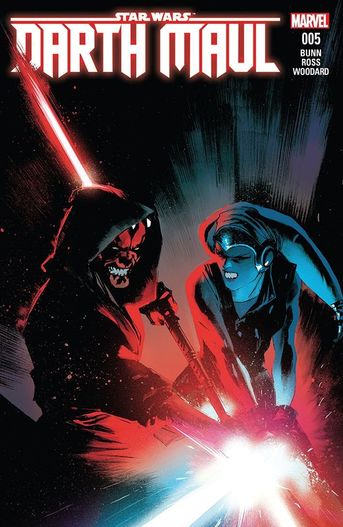 To characterize my first experience reading Cullen Bunn’s work as a roller coaster ride would not be inaccurate, or even an exaggeration. I've shifted from glee to frustration to about everything in between at least a dozen times over throughout the Darth Maul mini-series and finally we have arrived at the conclusion. I can only applaud Bunn and company for closing out the series with a well-crafted conclusion worthy of the Star Wars canon. There's not much to tell by way of plot in this issue as the majority of pages are taken up by the final Padawan/Sith showdown that the series promised from the very first installment. Blades clash as Maul ruminates over the joy of finally realizing his life's purpose: the extermination of Jedi Knights. Both colorist Nolan Woodard and artist Luke Ross shine as lightsaber blades flicker and play against the shadowy backdrop of the deserted Moon. As Maul and Eldra cross blades and match wits, Maul’s arrogance and over-confidence rear their ugly heads a few times, challenging his assumptions about his opponent and sparking his imagination with fantasies of turning Eldra to the dark side. This final battle is so effective first, as the culmination of the tension Bunn built up over the course of the first 4 issues of the series, but also as a delicate dance of character and sensibilities as Maul develops respect and near admiration for his opponent. There is an almost sweet moment following the final blow as Maul assures the fast-fading Padawan that though she had told him she was merely a pupil he considered her to be every inch a Jedi, and a worthy adversary. I must praise Luke Ross here again as the nuance that he brings to Darth Maul’s facial expression at the moment he defeats Eldra is spectacular and poignant. There is recognition and surprise that Ross conveys through Maul’s face that his internal monologue only makes plain in the final panels of the issue, several pages later. Maul is surprised at finally penetrating Eldra’s defenses but you can also see the loss he experiences as that final saber thrust snuffs out the prey he was so desperate to engage. Maul realizes in this moment that the purest joy of his life, the euphoria he will chase for the rest of his life, fighting and killing the Jedi, is so fleeting that he will never be satisfied. This self-awareness, while utterly devastating, does little to slake the Sith’s thirst for carnage as Xev Xrexus falls under his blade shortly after the Padawan’s death. Maul then returns to Coruscant and discovers that not only was his Master aware of his Padawan hunt, he also approved of the act of defiance. The series concludes with a profile of a creature molded for vengeance who has learned that his blood-lust will never be sated, and waits anxiously for the next opportunity to hunt the Jedi. One of the most remarkable feats of Bunn’s mini-series was the way he took a seemingly limiting period of Darth Maul’s history and told a pretty significant, character-driven story wherein both the audience and Darth Maul discover the futility and sadness that characterize his most fundamental desires. The relationship Bunn establishes between the Sith Lord and vengeance so effectively mirrors that between addict and addiction that we begin to reframe our understanding of Darth Maul. This is no small feat and I'm very impressed that Bunn was able to round out a character so inherently mysterious in only five issues. There were moments during this series when I was tempted to give up and I'm very pleased that my perseverance paid off. This creative team is superb and I'm excited to see more great comics from them in the future. Until next time, Geek On! Written by Joel T. Lewis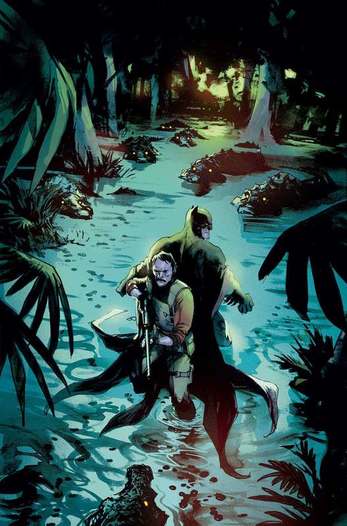 Trapped under the waves in a compromised submarine, Batman commandeers control of the craft with the following announcement to the crew and guests, ‘Listen up, people! As of this moment, you have a new captain...Captain Batman.’ You could fault Scott Snyder for riding the Pirate element of this final arc of All-Star Batman so hard if it wasn’t so damn fun. Batman narrowly escapes a watery grave with the assistance of a pair of torpedoes trained on the screaming voice of Alfred patrolling above the ocean’s surface and a trio of mermaids (sure, they’re actually underwater performers hired by the Pirate Tiger Shark but hey, they’re Mermaids all the same). Snyder then time-jumps back to a revived young Alfred who has been taken to a dungeon underneath the infamous Traitor’s Gate at the Tower of London and we finally learn about Alfred’s association with the twin-bladed knight from the previous issues. Alfred joins what was called the Nemesis Program, a tradition of errant knights who did the will of the British Crown as an enemy of the state in order to protect King and Country from the messiness of direct engagement via military force in the past or MI6 later in history. Agent Codename Briar became Alfred’s mentor with an eerie similarity to what Alfred in turn became for Bruce Wayne. Alfred became England’s Black Knight, and trained to serve the Crown by becoming its most cunning traitor. Now we as readers discover this truth several pages before it is revealed to a recovering Bruce Wayne whose dogged pursuit of the mysterious knight inspires an uncharacteristically violent objection from Alfred. Sitting up from his recovery bed next to a still incoherent Hush, Bruce senses his surrogate Father’s tone and inquires about Alfred’s history with the knight and as the Butler is explaining the folly of pursuing Briar and his new knight, machine gun fire from a helicopter interrupts their discussion. Turns out that the now-conscious Hush and the rapidly descending members of the Black and Whites (Black Mask, Penguin, and Great White Shark) had plotted together to manipulate Batman into obtaining the Genesis Engine from the very start and the issue concludes with Alfred bleeding from machine gun wounds and the building that Batman had made their base of operations crumbling around them as two wrecking balls smash into the walls. With every arc of All-Star Batman Snyder has chosen specific touchstone elements to explore with the characters of Batman. With ‘My Own Worst Enemy’ he showed a new layer of intimacy and immediacy to Batman’s stake in Harvey Dent’s fall from grace, with ‘Ends of the Earth’ he wove one-shot issues with distinct and unique villains together into a complex plot orchestrated by Ra’s al Ghul. But what I’ve loved about this final arc has been the care with which Snyder has dealt with the connection between Alfred and Bruce. Alfred has narrated every issue in this arc and the care and fatherly affection that is evident from how he talks about Bruce and his crusade is very satisfying as a Batman fan. Especially as we have become aware of the tension caused by Alfred’s absentee father and the specific cause of that void being the Wayne family it is truly touching to see the flawed, but loving father figure that Alfred has become. Too often Alfred is set dressing or comic relief. In this comic for the first time I really feel that I have a deeper understanding of the man behind the man behind Batman. The Batman paradigm doesn’t function without Alfred, and with this story Snyder has shown us just how lost Bruce would be without his Butler, and how lost Alfred would be without Bruce. Until next time, Geek On! |
Archives
May 2024
|
|
© 2012-2025, Nerds That Geek LLC.
All Rights Reserved. |
uWeb Hosting by FatCow
